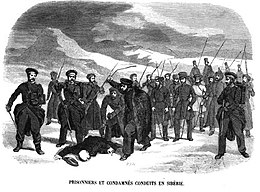Deportation


Deportation is the expulsion of a person or group of people from a territory. The actual definition changes depending on the place and context, and it also changes over time.[1][2][3][4] Forced displacement or forced migration of an individual or a group may be caused by deportation, for example ethnic cleansing, and other reasons. A person who has been deported or is under sentence of deportation is called a deportee.[5]
Definition
Definitions of deportation vary, with some implicating "transfer beyond State borders" (distinguishing it from forcible transfer),[2] others considering it "the actual implementation of [an expulsion] order in cases where the person concerned does not follow it voluntarily",[3] and others differentiating removal of legal immigrants (expulsion) and illegal immigrants (deportation).[6]
This article approaches deportation in the most general sense, in accordance with International Organization for Migration,[7] which defines expulsion and deportation synonyms in the context of migration, adding:
"The terminology used at the domestic or international level on expulsion and deportation is not uniform but there is a clear tendency to use the term expulsion to refer to the legal order to leave the territory of a State, and removal or deportation to refer to the actual implementation of such order in cases where the person concerned does not follow it voluntarily."[8]
According to the European Court of Human Rights, collective expulsion is any measure compelling non-nationals, as a group, to leave a country, except where such a measure is taken on the basis of a reasonable and objective examination of the particular case of each individual non-national of the group. Mass expulsion may also occur when members of an ethnic group are sent out of a state regardless of nationality. Collective expulsion, or expulsion en masse, is prohibited by several instruments of international law.[9]
History
Antiquity
Expulsions widely occurred in ancient history, and is well-recorded particularly in
Deportation in the Achaemenid Empire
Deportation was practiced as a policy toward rebellious people in Achaemenid Empire. The precise legal status of the deportees is unclear; but ill-treatment is not recorded. Instances include:[10]
| Deported people | Deported to | Deporter |
|---|---|---|
| 6,000 Egyptians (including the king Amyrtaeus and many artisans)
|
Susa | Cambyses II |
| Barcaeans | A village in Bactria | Darius I
|
| Paeonians of Thrace | Asia Minor (later returned)
|
Darius I |
| Milesians | Ampé, on the mouth of Tigris near the Persian Gulf | Darius I |
| Carians and Sitacemians | Babylonia
|
|
Eretrians
|
Ardericca in Susiana | Darius I |
| Beotians | Tigris region | |
| Sidonian prisoners of war | Susa and Babylon | Artaxerxes III |
| Jews who supported the Sidonian revolt[11] | Hyrcania | Artaxerxes III |
Deportation in the Parthian Empire
Unlike in the Achaemenid and Sassanian periods, records of deportation are rare during the
Hyrcanus II, the Jewish king of Judea (Jerusalem), was settled among the Jews of Babylon in Parthia after being taken as captive by the Parthian-Jewish forces in 40 BC.[12]
Roman POWs in the
Deportation in the Sasanian empire
Deportation was widely used by the Sasanians, especially during the
During
After the Arab incursion into Persia during
In 395 AD 18,000 Roman populations of
Major deportations occurred during the Anastasian War, including Kavad I's deportation of the populations of Theodosiopolis and Amida to Arrajan (Weh-az-Amid Kavad).[10]
Major deportations occurred during the campaigns of
Middle ages
This section needs expansion. You can help by adding to it. (January 2024) |
The Medieval European age was marked with several large religious deportations, namely of Jews and Muslims.
Modern deportation
With the beginning of the
Meanwhile, in Japan during Sakoku, all portuguese and spanish were expelled from the country.
In the 18th century the Tipu Sultan, of Mysore, deported tens of thousands of civilians, from lands he had annexed, to serve as slave labour in other parts of his empire, for example the: Captivity of Mangalorean Catholics at Seringapatam.[19]
In the late 19th century the United States of America began designating "desired" and "undesired" immigrants, leading to the birth of illegal immigration and subsequent deportation of immigrants when found in irregular situations.[20] Starting with the Chinese Exclusion Act, the US government has since deported more than 55 million immigrants, the majority of whom came from Latin-American countries.[21]
At the beginning of the 20th century the control of immigration began becoming common practice, with the Immigration Restriction Act 1901 in Australia,[22] the Aliens Act 1905 in the United Kingdom[23] and the Continuous journey regulation of 1908 in Canada,[24] elevating the deportation of "illegal" immigrants to a global scale.
In the meantime, deportation of "regular residents" also increased.
Deportation in the US
In the 1930s, during the Great Depression, more stringent enforcement of immigration laws were ordered by the executive branch of the U.S. government, which led to increased deportation and repatriation to Mexico. In the 1930s, during the Great Depression, between 355,000 and 2 million Mexicans and Mexican Americans were deported or repatriated to Mexico, an estimated 40 to 60% of whom were U.S. citizens – overwhelmingly children. At least 82,000 Mexicans were formally deported between 1929 and 1935 by the government. Voluntary repatriations were more common than deportations.[25][26] In 1954, the executive branch of the U.S. government implemented Operation Wetback, a program created in response to public hysteria about immigration and immigrants from Mexico.[27] Operation Wetback led to the deportation of nearly 1.3 million Mexicans from the United States.[28][29]
Deportation in Nazi Germany
Deportation in the Soviet Union
Under orders of Joseph Stalin the Soviet Union carried out a forced transfer of various groups before, during and after World War II (from 1930s up to the 1950s). During the June deportation of 1941, after the occupation of the Baltic countries, Eastern Poland and Moldavia, as was agreed by the Soviet Union and Nazi Germany in the Molotov–Ribbentrop Pact, in an attempt to subdue the countries for their forced incorporation into the Soviet Union, the Soviet Union deported tens-of-thousands of innocent people to Siberia.[33]
Deportation in the Independent State of Croatia
An estimated 120,000
Present scenario
All countries reserve the right to deport persons without
Since the 1980s, the world also saw the development of practices of externalization/"offshoring immigrants", currently being used by Australia, Canada, the United States, the European Union.[36] and the United Kingdom.[37] Some of the countries in the Persian Gulf have even used this to deport their own citizens. They have paid the Comoros to give them passports and accept them.[38][39]
Noteworthy deportees
Opposition

Many criticize deportations, calling them inhuman, as the questioning the effectiveness of deportations. Some are completely opposed towards any deportations, while others state it is inhuman to take somebody to a foreign land without their consent.[40][41][42]
In popular culture
In literature, deportation appears as an overriding theme in the 1935 novel, Strange Passage by Theodore D. Irwin. Films depicting or dealing with fictional cases of deportation are many and varied. Among them are Ellis Island (1936), Exile Express (1939), Five Came Back (1939), Deported (1950), and Gambling House (1951). More recently, Shottas (2002) treated the issue of U.S. deportation to the Caribbean post-1997.
See also
- Ethnic cleansing
- Forced migration
- Acadian deportation
- Diaspora
- Depopulation of Diego Garcia
- Flight and expulsion of Germans (1944–50)
- Impediment to expulsion
- Indian Removal Act
- Israelite deportation
- June deportation
- Operation Priboi
- Penal transportation
- Population transfer
- Population transfer in the Soviet Union
- Prussian deportations of 1885–1890
- Seminole Wars
- Soviet deportations from Estonia
- Exile
References
Notes
- ^ "EMN Asylum and Migration Glossary – Removal". European Commission.
- ^ a b "Case Matrix Network – Art. 7(1)(d) 5". Case Matrix Network.
- ^ a b "Aliens, Expulsion and Deportation". Oxford Public International Law.
- ISBN 90-411-0072-5.
- ^ "Definition of DEPORTEE". www.merriam-webster.com. Retrieved 2021-02-25.
- ^ "DISGUISED EXTRADITION, I.E. SURRENDER BY OTHER MEANS". Council of Europe.
- ^ "International Migration Law No. 34 – Glossary on Migration". IOM. 19 June 2019.
- ^ W. Kälin, ‘Aliens, Expulsion and Deportation’ in R. Wolfrum (ed) Max Planck Encyclopedia of Public International Law (2014).
- ^ IOM 2011, p. 35.
- ^ A. Shapur Shahbazi, Erich Kettenhofen, John R. Perry, "DEPORTATIONS," Encyclopædia Iranica, VII/3, pp. 297–312, available online at "DEPORTATIONS – Encyclopaedia Iranica". (accessed on 30 December 2012).
- ISBN 0-8028-0966-9.
- ISBN 9789004308473.)
{{cite book}}: CS1 maint: location (link - S2CID 191495778.
- ^ Christensen, The Decline of Iranshahr: Irrigation and Environments in the History of the Middle East, 500 B.C. to A.D. 1500, 1993. [page needed]
- ^ Russell-Wood (1998:p.106-107)
- ^ ISBN 978-1741668001.
- ^ Daniels, Coming to America: A History of Immigration and Ethnicity in American Life, 2002
- ^ McCaffray and Melancon, p. 171.
- ISBN 978-81-7525-126-7.
- ^ "The Birth of 'Illegal' Immigration". www.history.com. 2017-09-17.
- ISBN 978-0-19-932917-5.
- Museum of Australian Democracy. Retrieved 7 November 2016.
- ^ David Rosenberg, 'Immigration' on the Channel 4 website
- ^ Johnston, Hugh (1995). "Exclusion". The Voyage of the Komagata Maru: The Sikh's challenge to Canada's colour bar. Vancouver: UBC Press. p. 138. Retrieved 13 March 2022.
The Canadian government tried to stop the Indian influx with a continuous passage order-in-council issued 8 Jan. 1908, but it was loosely drafted and successfully challenged in court
- ^ Gratton, Brian; Merchant, Emily (December 2013). "Immigration, Repatriation, and Deportation: The Mexican-Origin Population in the United States, 1920–1950" (PDF). Vol. 47, no. 4. The International migration review. pp. 944–975.
- ^ McKay, "The Federal Deportation Campaign in Texas: Mexican Deportation from the Lower Rio Grande Valley During the Great Depression", Borderlands Journal, Fall 1981; Balderrama and Rodriguez, Decade of Betrayal: Mexican Repatriation in the 1930s, 1995; Valenciana, "Unconstitutional Deportation of Mexican Americans During the 1930s: A Family History and Oral History", Multicultural Education, Spring 2006.
- ISBN 0-674-01629-7("... Operation Wetback revived Depression-era mass deportations. Responding to public hysteria about the 'invasion' of the United States by 'illegal aliens', this campaign targeted large Mexican communities such as East Los Angeles."); Jaime R. Aguila, "Book Reviews: Decade of Betrayal: Mexican Repatriation in the 1930s. By Francisco E. Balderrama and Raymond Rodríguez", Journal of San Diego History, 52:3–4 (Summer-Fall 2006), p. 197. ("Anti-immigrant hysteria contributed to the implementation of Operation Wetback in the mid 1950s....")
- ISBN 0-313-21353-4
- ISBN 1-59213-232-4
- ^ Deportation to the Death Camps, Yad Vashem
- Holocaust – The International Institute for Holocaust Research, Yad Vashem
- ^ "Holocaust Glossary". Scholastic.
- ^ "The Soviet Massive Deportations – A Chronology". SciencesPo. 5 November 2007.
- ISBN 0-253-34656-8.
- ^ Henckaerts, Mass Expulsion in Modern International Law and Practice, 1995, p. 5; Forsythe and Lawson, Encyclopedia of Human Rights, 1996, pp. 53–54.
- ISBN 978-0-19-087417-9.
- Bloomberg UK. Retrieved 12 May 2022.
- ISSN 0015-7120. Retrieved 2024-01-03.
- ^ "To silence dissidents, Gulf states are revoking their citizenship". The Economist. 26 November 2016.
- ^ "Mass deportation isn't just inhumane. It's ineffective. – The Washington Post". The Washington Post.
- ^ "Analysis: Deaths during forced deportation".
- S2CID 159652908.
Bibliography
- Aguila, Jaime R. "Book Reviews: Decade of Betrayal: Mexican Repatriation in the 1930s. By Francisco E. Balderrama and Raymond Rodríguez". Journal of San Diego History. 52:3–4 (Summer-Fall 2006).
- Balderrama, Francisco and Rodriguez, Raymond. Decade of Betrayal: Mexican Repatriation in the 1930s. Albuquerque: University of New Mexico Press, 1995. ISBN 0-8263-1575-5.
- Campana, Aurélie. "Case Study: The Massive Deportation of the Chechen People: How and why Chechens were Deported". Online Encyclopedia of Mass Violence. November 2007. Accessed August 11, 2008.
- Christensen, Peter. The Decline of Iranshahr: Irrigation and Environments in the History of the Middle East, 500 B.C. to A.D. 1500 Copenhagen, Denmark: Museum Tusculanum Press, 1993. ISBN 87-7289-259-5.
- Conquest, Robert. The Nation Killers. New York: Macmillan, 1970. ISBN 0-333-10575-3
- Daniels, Roger. Coming to America: A History of Immigration and Ethnicity in American Life. New York: HarperCollins, 2002. ISBN 0-06-050577-X
- Dillman, Caroline Matheny. The Roswell Mills and A Civil War Tragedy: Excerpts From Days Gone by in Alpharetta and Roswell, Georgia. Vol. 1. Roswell, Ga.: Chattahoochee Press, 1996. ISBN 0-9634253-0-7
- Fischer, Ruth and Leggett, John C. Stalin and German Communism: A Study in the Origins of the State Party. Edison, N.J.: Transaction Publishers, 2006. ISBN 0-87855-822-5
- Forsythe, David P. and Lawson, Edward. Encyclopedia of Human Rights. 2d ed. Florence, Ky.: Taylor & Francis, 1996.
- Fragomen, Austin T. and Bell, Steven C. Immigration Fundamentals: A Guide to Law and Practice. New York: Practising Law Institute, 1996. ISBN 0-87224-093-2
- García, Juan Ramon. Operation Wetback: The Mass Deportation of Mexican Undocumented Workers in 1954. Westport, Ct.: Greenwood Publishing Group, 1980. ISBN 0-313-21353-4.
- Gibney, Matthew J. and Hansen, Randall. "Deportation and the Liberal State: The Involuntary Return of Asylum Seekers and Unlawful Migrants in Canada, the UK, and Germany". New Issues in Refugee Research: Working Paper Series No. 77. Geneva, Switzerland: United Nations High Commissioner for Refugees, 2003.
- Gutiérrez, David G. Walls and Mirrors: Mexican Americans, Mexican Immigrants, and the Politics of Ethnicity. Berkeley, Calif.: University of California Press, 1995. ISBN 0-520-20219-8
- Henckaerts, Jean-Marie (1995). Mass Expulsion in Modern International Law and Practice. The Hague: M. Nijhoff. ISBN 90-411-0072-5.
- Hing, Bill Ong. Defining America Through Immigration Policy. Philadelphia, Pa.: Temple University Press, 2004. ISBN 1-59213-233-2
- Hitt, Michael D. Charged with Treason: The Ordeal of 400 Mill Workers During Military Operations in Roswell, Georgia, 1864–1865. Monroe, N.Y.: Library Research Associates, 1992. ISBN 0-912526-55-6
- International Law Commission. United Nations. Yearbook of the International Law Commission 1996: Report of the Commission to the General Assembly on the Work of Its 48th Session. New York: United Nations Publications, 2000. ISBN 92-1-133600-7
- Iorizzo, Luciano J.; Rossi, Ernest E. (2010). Italian Americans: Bridges to Italy, Bonds to America. Youngstown, N.Y.: Teneo Press. ISBN 9781934844144.
- Jaimoukha, Amjad M. The Chechens: A Handbook. Florence, Ky.: Routledge, 2005. ISBN 0-415-32328-2
- Kennedy, David M. (1999). Freedom from Fear: The American People in Depression and War, 1929–1945. Cambridge, Massachusetts: Oxford University Press. ISBN 0195038347.
- Kleveman, Lutz. The New Great Game: Blood and Oil in Central Asia. Jackson, Tenn.: Atlantic Monthly Press, 2003. ISBN 0-87113-906-5
- "The Law of Necessity As Applied in the Bisbee Deportation Case". Arizona Law Review. 3:2 (1961).
- "Lewis Attacks Deportation of Leaders by West Virginia Authorities". The New York Times. July 17, 1921.
- Lindquist, John H. and Fraser, James. "A Sociological Interpretation of the Bisbee Deportation". Pacific Historical Review. 37:4 (November 1968).
- López, Ian F. Haney. Racism on Trial: The Chicano Fight for Justice. New ed. Cambridge, Massachusetts: Belknap Press, 2004. ISBN 0-674-01629-7
- Martin, MaryJoy. The Corpse On Boomerang Road: Telluride's War on Labor, 1899–1908. Lake City, Colo.: Western Reflections Publishing Co., 2004. ISBN 1-932738-02-9
- Mata, Albert G. "Operation Wetback: The Mass Deportation of Mexican Undocumented Workers in 1954 by Juan Ramon García". Contemporary Sociology. 1:5 (September 1983)
- Mawdsley, Evan. The Stalin Years: The Soviet Union 1929–1953. Manchester, England: Manchester University Press, 2003. ISBN 0-7190-6377-9
- McCaffray, Susan Purves and Melancon, Michael S. Russia in the European Context, 1789–1914: A Member of the Family. New York: Palgrave Macmillan, 2005.
- McKay, Robert R. "The Federal Deportation Campaign in Texas: Mexican Deportation from the Lower Rio Grande Valley during the Great Depression". Borderlands Journal. (Fall 1981).
- Naimark, Norman M. Fires of Hatred: Ethnic Cleansing in Twentieth-Century Europe. Cambridge, Massachusetts: Harvard University Press, 2001. ISBN 0-674-00994-0
- Nurbiyev, Aslan. "Relocation of Chechen 'Genocide' Memorial Opens Wounds". Agence France Press. June 4, 2008.
- Perruchoud, Richard; Jillyanne Redpath-Cross, eds. (2011). Glossary on Migration. International Migration Law (Second ed.). Geneva: ISSN 1813-2278.
- President's Mediation Commission. Report on the Bisbee Deportations Made by the President's Mediation Commission to the President of the United States. Washington, D.C.: President's Mediation Commission, November 6, 1917.
- Silverberg, Louis G. "Citizens' Committees: Their Role in Industrial Conflict". Public Opinion Quarterly. 5:1 (March 1941).
- Smith, Cary Stacy; Hung, Li-Ching (2010). The Patriot Act: Issues and Controversies. Springfield, Ill.: C.C. Thomas Publisher. ISBN 9780398079123.
- Suggs, Jr., George G. Colorado's War on Militant Unionism: James H. Peabody and the Western Federation of Miners. 2nd ed. Norman, Okla.: University of Oklahoma Press, 1991. ISBN 0-8061-2396-6
- Tetsuden, Kashima (2003). Judgment Without Trial: Japanese American Imprisonment During World War II. Seattle: University of Washington Press. ISBN 0295982993.
- Valenciana, Christine. "Unconstitutional Deportation of Mexican Americans During the 1930s: A Family History and Oral History". Multicultural Education. Spring 2006.
Further reading
- Garrity, Meghan (2022). "Introducing the Government-Sponsored Mass Expulsion Dataset". Journal of Peace Research.
External links
 Media related to Deportation at Wikimedia Commons
Media related to Deportation at Wikimedia Commons
